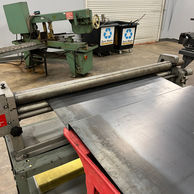
Mobile Repair Station
Design Research
This research delves into the accessibility and acquisition of repair skills within the Tempe ASU community, with the goal of providing valuable insights to empower individuals in making sustainable decisions for a brighter future.
Project Type
Research
Time
15 weeks
Semester
8, Spring 2024
The Project
In my final semester, I began assisting Hazal Gümüş Çiftçi, Ph.D with her ongoing design research on repair and the circular economy.
My involvement in the research included activities such as: desk research about repair and circular economy, interviews, and the design and fabrication of a mobile system for repair to attract general public to mend their broken items.

The Mobile Repair Station is still under development; more content is coming soon!
In the meantime, here is a brief overview of the project:
Project Phases


The Linear Product Cycle
On August 2, 2023, humanity exceeded the amount of resources that Earth can regenerate in a year (Global Footprint Network, 2023). As the population grows, our inefficient use of resources and overconsumption habits pose a serious risk to the long term sustainability of our planet.
While the burden of this issue does not solely fall on consumers, the involvement of the general public in sustainable initiatives has a considerable impact on facilitating the transition towards a more sustainable future.


Repairing The Cycle
This research delves into the accessibility and acquisition of repair skills within the Tempe ASU community, with the goal of providing valuable insights to empower individuals in making sustainable decisions for a brighter future.
Objectives
Conduct place-based research
involving observation and interviews to understand the target population and their repair needs / abilities
.png)
Design + Build a Mobile Repair Station
To host and facilitate repair activities
.png)
Collect and Review Data
Identify barriers to repair practices to improve interventions and repair demonstrations
.png)
Mobile Repair Station
01
Extendable Workspaces
02
Seating
03
Modular Storage
04
Portable Workspace


01
02
03
04

Storyboard
Fabrication
I designed, engineered, budgeted for, acquired materials, built, tested, and re-built a full-scale prototype within 8 weeks
Given the constraints of time, material availability, and fabrication equipment, the cart was meticulously designed to be both functional and feasible.
This was the most rewarding aspect of the project, as it allowed me to simultaneously leverage my experience in engineering, design, and fabrication to create a tangible and purposeful product with my own hands.
Fabrication techniques utilized:
-
Sheet metal forming (bending, rolling)
-
CNC router programming (wood)
-
Powder coating and pneumatic spray painting
-
MIG and TIG welding
-
Mechanical cutting (hand cutting, drilling, etc)
Photos of the fabrication process:
The Future of Repair
By empowering students with the knowledge to repair, we are not just fixing products, but nurturing a mindset of sustainability and responsibility. Together, we can shape a future where mindfulness and resourcefulness pave the way for a better tomorrow.

























